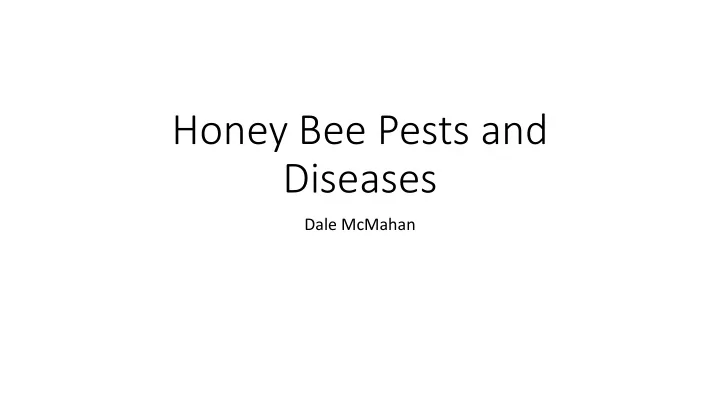

Honey Bee Pests and Diseases Dale McMahan
Honey Bee Pests and Diseases Pests Diseases • American Foul Brood • Varroa Mite • European Foul Brood • Trachael Mite • Nosema • Wax Moth • Chalk Brood • Small Hive Beetle • Sac Brood • Deformed Wing Virus (not covered) • K-Wing Virus (not covered) • Israeli Acute Paralysis Disease (not covered)
Varroa Mite
Varroa Mite on Adult Bees
Varroa Mite on Pupae
Varroa Life Cycle
Sticky Board Method to Monitor Mite Levels
Sugar Roll/Alcohol Wash Methods to Monitor Mite Levels
Varroa Treatments
Varroa Treatment Guidelines • There is a bewildering number of treatments available. Some claim to be organic, natural, non-toxic to bees. Don’t believe it. If it kills mites it will kill bees too • All treatments are based on chemicals that can and sometimes do kill honeybees. • Remember, no matter which method you choose….the label is the law. Follow directions religiously • Some treatments can’t be applied with honey in the hive, some cant be applied with brood in the hive. • Since varroa mites reproduce in capped cells keep in mind that some treatments cannot penetrate the cell caps and must be repeated three times to ensure an effective mite reduction • Oxalic acid shop towel method is showing promise but it is early • The only non-chemical method of control is using drone frames • Varroa is a vector for deformed wing virus (DWV) and Israeli Acute Paralyisi and may be a visible indicator of mite infestation
Nosema (A gut disease caused by a microsporidian)
Nosema Detection • Two types of nosema: 1. nosema apis, 2 nosema cerana • Spread via spores which can live 22 – 50 days outside the colony • Low temps – not warm temps kill nosema (39F or lower for 4 days) • Spores enter thru trophylaxis then to esophagus to proventriculus (honey stomach). • Most noticeable because of spotting on front of hive and top of frames. • Nosema cerana is a silent killer. NO SPOTTING • Both types causes malnourishment, early death of bees • Because of early death many adult bees revert to performing the duties of younger bees
Nosema Detection and Treatment Collect at least 30 bees in a sandwich bag from inside cover of colony Place baggie in freezer for 30 minutes Select 15 bees and macerate them in 15 mL water Filter the bees and water thru a tissue paper Place 1 drop of filtered solution on microscope slide, view at 400X If three fields of views show an average of 15 spores per view treatment is required. Treat with Funagillin B per instructions on package
American Foulbrood
American Foulbrood Diagnosis • Sunken, perforated cell caps • Dirty socks, sulfur (foul) odor • Decimated brood in irregular pattern • Fecal matter in cells • Place a toothpick into a brood cell, swirl it around and slowly pull it out of cell. If contents in cell come out with toothpick in a stringy rope this is most likely AFB
American Foulbrood Treatment • Spread via spores (similar to anthrax) • Spores may live 40 years • There is no approved treatment for American Foulbrood. But many beekeepers use Oxytetracycline or Tylosin as a preemptive measure • This disease is highly contagious and must be contained • Bees and equipment must be burned • Contact state apiarist if you are unsure of diagnosis
European Foulbrood
European Foulbrood Treatment • Can be treated when no nectar flow is occurring • Pull existing honey off of colony • Musty, fish like smell • Not ropy like AFB • Can be treated with Terramyacin, Tylosin
Tracheal Mite
Tracheal Mite Monitoring and Treatment • Monitoring • Treatment • requires collecting adult bees and • Menthol based treatments are effective dissection • Apiguard • Adult mites pierce the tracheal wall and • Thymol feed on hemolymph • Normal trachea are white • Infected trachea are brown to black • No one symptom defines tracheal mites • Colonies appear normal until death occurs, usually in spring • May be a vector for K-Wing virus • Could also show dysentery and excessive swarning.
Chalk Brood/Sac Brood Chalk Brood Sac Brood
Chalk Brood/Sac Brood Treatment Chalk Brood Treatment Sac Brood Treatment • Fungal Disease • Fungal Disease • Mummies drug out by bees • The larvae appears to be appear to be white and encased in a sac sometimes black (mummified) • Disappears in summer • Disappears in summer • Requeening helps • Requeening helps
Small Hive Beetle
Small Hive Beetle Trap Examples
Small Hive Beetle Detection and Treatment • Small hive beetles hide in the dark recesses within the hive • There are many traps that all function on the same principle – lure the beetle into a tight space and drown it in oil or a miteacide • CD Jewel case is an easy and effective homemade trap • If beetles are not evident perform this test – place outer cover upside down on ground then place top super into cover in full sun. Beetles will crawl to bottom of super to get out of light. Wait 10 minutes and lift up super to reveal beetles in cover • A deterrent is to always place colonies in full sun and away from wooded areas.
Wax Moth
Wax Moth Control • Wax moths usually occur in late summer and fall • Wax moths will invade stored empty supers and weak hives • Stack empty supers 5 tall and place a paper plate or newspaper on frames of top super • Sprinkle ¼ cup paradichlorobenzyne on paper • Cover stack of supers with large garbage bag or tarp • Cover must be air-tight
Recommend
More recommend